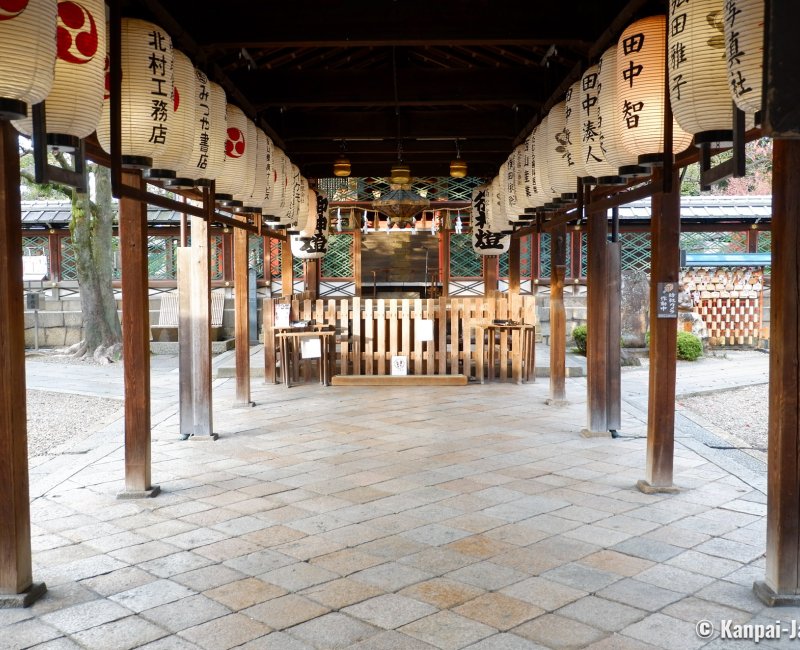Gokonomiya-jinja
The Miraculous Spring in Fushimi
Gokonomiya-jinja is a Shinto shrine located in Fushimi ward in the south of Kyoto. The spiritual site is renown for a natural spring with healing properties and is also consecrated to Empress Jingu who is prayed for a safe childbirth. The main worshiping pavilions display very colorful, authentic constructions.
Gokonomiya-jinja is next to the Fushimi sake 🍶 breweries district, and worth the detour for:
- Its history closely related to the troubled past of this southern ward of Kyoto; and,
- The colorful decoration of its main buildings’ facades.
Gokosui spring
Although its origins are unclear, the shrine was first documented under the name "Mimoro" in 862 when a pure water source was found within its grounds. According to the legend, the natural spring 🌸 exuded an exceptional fragrance and contributed to the miraculous healing of several sick people. Emperor Seiwa (850 - 881) is said to have renamed the shrine "Gokonomiya-jinja" in reference to the sacred fountain called Gokosui (御香水). This fountain, still in use today, is located in front of the main pavilion and worshipers still take a sip of its perfumed water in hope of healing their ailments.
Later, daimyo warlord Toyotomi Hideyoshi (1537 – 1598) decided to relocate the spiritual site within Fushimi Castle 🏯’s enclosure to enjoy its protection. In 1605, shogun Tokugawa Ieyasu (1543 - 1616) ordered that Gokonomiya-jinja was moved back to its initial location. The shrine was also used as the headquarters of the Meiji Imperial Army for the Battle of Toba-Fushimi (January 1868) during the Boshin War (1868 - 1869).

Colorful facade ornamentations
The Omote-mon gate, salvaged from the former Fushimi Castle, is guarding Gokonomiya’s enclosure. Of an impressive size and carved in a dark wood, it is adorned with a long shimenawa sacred rope. On the other side of its threshold, the rectilinear paved alley leads the way. Thus, visitors first walk by the secondary shrine Momoyama Tenman-gu (桃山天満宮) sided by 2 ginkgoes of a bright yellow foliage in autumn 🍁. Founded in 1394, the pavilion is dedicated to Sugawara no Michizane (845 – 903), a man of letters and important statesman of the Heian period Japan (794 - 1185).
The cult pavilion haiden stands at the center of the site’s main esplanade. Rebuilt in 1625 thanks to the donations of daimyo Tokugawa Yorinobu (1602 – 1671), it displays a beautiful karahafu (唐破風) curved gable picturing the Toryumon myth (登龍門) of a carp swimming upstream and transforming into a powerful dragon.
Painted in vivid colors, these carvings are particularly beautiful and a remarkable preservation work has been carried out on these ornaments. In the continuation of the haiden and at the end of a covered passage bordered by beautiful lanterns 🏮, stands the main hall honden. The current construction dates to 1605 and also bears colorful sculpted facades.

The path continues into the grounds and allows to discover:
- The Ema-do pavilion;
- A Noh theater stage;
- A splendid Japanese sago palm cycas; and,
- The stone garden sekitei (石庭) designed by Kinsaku Nakane as a tribute to Kobori Enshu (1579 – 1647), the architect of the garden formerly laid at the very same place and that Tokugawa Iemitsu enjoyed, so much that he appointed Enshu to the title of daimyo.
The walk in Gokonomiya-jinja’s premises lasts less than 1 hour and is a pleasant complement to a day trip in southern Kyoto’s Fushimi historical district.

